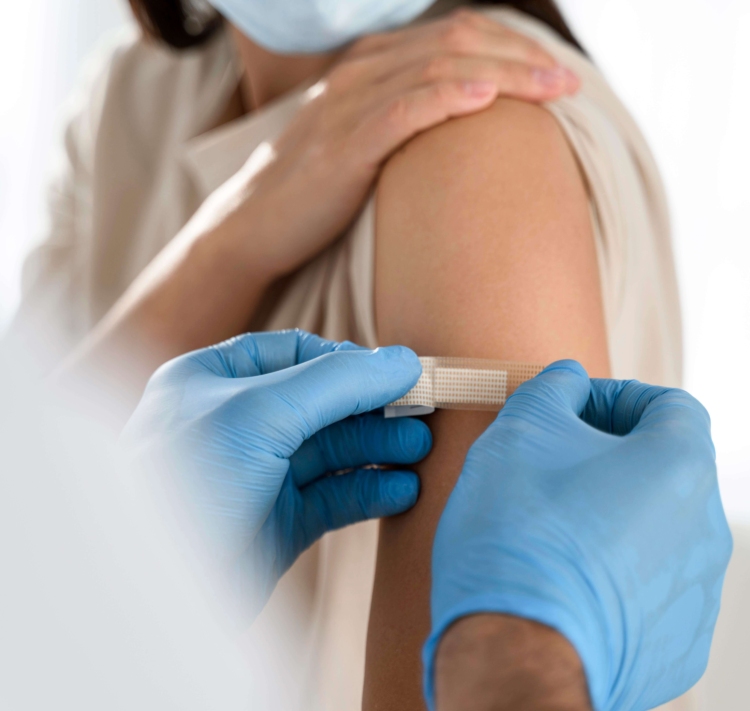One thing is certain: having your children vaccinated represents a major step towards avoiding many an inconvenience. There do exist, however, contagious diseases for which there are no vaccines yet. Trust your pharmacist to advise you on the best preventive tools and to quickly guide you when your child experiences issues with their health.
As parents, you know your child better than anyone else. When in doubt regarding the state of their health, do not delay – consult your pharmacist, either in person or remotely via a virtual appointment. They can recommend the right treatment or direct you, if needed, to the proper healthcare services.
To give you the upper hand, here is an overview of some of the most common early childhood diseases, their characteristics and associated symptoms:
Chicenpox
Symptoms – Low-grade fever and chills, followed by the appearance of red bumps that can spread over the entire body. This rash provokes intense itching, and blemish causes blisters. Symptoms generally persist for 7 to 14 days.
Treatment – When symptoms appear, it is suggested to lower the child’s fever by administering acetaminophen, and to relieve itching using an antihistamine combined with calamine applied topically. Another interesting option is to treat affected areas with colloidal oatmeal. Cutting baby’s nails and sliding on mittens that decrease scratching can spare baby from unnecessary crying.
Transmission – Highly contagious, the chickenpox virus spreads from person to person through airborne transmission. Children are contagious 1 to 2 days before rash appears up until lesions crust over.
Vaccine – The chickenpox is effectively prevented using the MMRV combined vaccine, recommended at the age of 18 months. The MMRV vaccine also protects against the measles, mumps and rubella.
Participation in group activities – Do not exclude the affected child unless their health condition does not permit it.
Roseola
Symptoms – Occurs mostly in babies less than 1 year of age, sometimes in babies up to 2 years of age. Roseola is characterized by a high fever and irritability that last 3 to 5 days, after which light pink bumps appear on the face and body. These can last as little as a few hours or can persist for 2 days.
Treatment – There is no known cure or remedy. Unless the affected child is uncomfortable, it is not necessary to administer fever medication, as the fever will break on its own.
Transmission – Roseola spreads via direct and indirect contact with airway secretions (does the term “droplets” ring a bell?) and saliva.
Vaccine – None exists. As is the case for all viruses, frequent hand-washing is a good method of prevention.
Participation in group activities – Do not exclude the affected child unless their health condition does not permit it.
Erythema infectosium (5th disease)
Symptoms – Fifth disease symptoms are similar to those of a cold and can be accompanied by a low-grade fever, as well as muscle and joint pains. The 5th disease causes redness on the cheeks, 7 to 10 days later, which progressively spreads to the torso, arms and the rest of the body. The effects of this infection can linger for a few days and up to 3 weeks, sometimes even longer. If you are pregnant and one of your children has the 5th disease, see your doctor, as this virus can cause fetal harm.
Treatment – There is no known remedy. Erythema infectosium disappears on its own over time. If needed, apply calamine or fragrance-free hydrating lotion to relieve itching.
Transmission – The 5th disease spreads through contact with hands or objects, as well as airborne droplets. Once redness occurs, the affected child is no longer contagious.
Vaccine – None exists. As is the case for all viruses, frequent hand-washing is a good method of prevention.
Participation in group activities – Do not exclude the affected child unless their health condition does not permit it.
Whooping cough (pertussis)
Symptoms – Caused by the Bordetella pertussis bacterium, whooping cough affects the lungs and the airways, causing hacking coughing fits, followed by a high-pitched intake of breath that sounds like a “whoop”, hence its name. Whooping cough also makes for a runny nose, redness in the eyes and sometimes a fever. Symptoms can last 6 to 10 weeks, and the cough associated with pertussis can persist even beyond that length of time.
Treatment – Whooping cough can be especially dangerous in babies younger than 1 year, and in such cases, it is imperative that the baby be examined by a doctor. Whooping cough must nonetheless not be underestimated at any age, and it requires antibiotic treatment.
Transmission – Contamination occurs mainly through airborne transmission, generally from the affected child’s cough. Said child remains contagious for up to 5 days after initiation of antibiotic treatment, or for up to 3 weeks following the onset of a cough, or until coughing stops completely.
Vaccine – A 5-dose vaccination regimen is 90% effective against pertussis when administered during the first 4 to 6 years of a child’s life. It is estimated that during pregnancy, immunization of expectant mothers with the Tdap vaccine protects about 90% of newborns younger than 3 months of age.
Participation in group activities – The affected child must be excluded for up to 5 days after the initiation of antibiotic treatment. In the absence of treatment, exclusions must be extended up to 3 weeks following the onset of a cough or until coughing stops completely, whichever occurs first.
Scarlet fever (scarlatina)
Symptoms – Scarlet fever mostly affects children 5 to 15 years of age. It is characterized by high fever accompanied by whitish lesions on the tongue, a sore and burning throat, as well as great fatigue. Small red bumps appear in folds (underarms, behind the knees, etc.) before spreading to the rest of the body, and skin can become dry and rough in some places (like sandpaper). Scarlatina also causes a whitish film to appear on the tongue.
Treatment – It is recommended to see a doctor, because the child’s condition could require antibiotics. Acetaminophen can be used to bring down fever.
Transmission – Scarlet fever spreads from person to person through coughing and sneezing, or through contact with contaminated objects. Sore throat lasts 2 to 3 days, and rash can last 1 week. The affected child ceases to be contagious 24 hours after the initiation of antibiotic treatment. In the absence of antibiotic treatment, contagion can occur within a period of 21 days.
Vaccine – None exists.
Participation in group activities – Their health condition permitting, the affected child can resume group activities 24 hours after the initiation of antibiotic treatment.
Hand-foot-mouth disease (HFMD)
Symptoms – Onset of fever accompanied by red bumps in the mouth that resemble tiny bubbles and cause a sore throat. Pimples appear, mainly in the palms of the hands and on the feet. These symptoms cause irritability, refusal to eat, diarrhea and sometimes vomiting. HFMD is most often benign and occurs most frequently in summer and at the beginning of autumn.
Treatment – No known treatment exists. HFMD heals on its own, and rarely lasts longer than 10 days. Acetaminophen can be administered in order to lower fever if needed.
Transmission – Highly contagious, hand-foot-mouth disease easily spreads through the affected child’s saliva, secretions or fecal matter, but also through their hands and contact with contaminated objects. The virus can remain present in the feces for several weeks, even months.
Vaccine – None exists.
Participation in group activities – Do not exclude the affected child unless their health condition does not permit it.
___________________________________
Vaccines are effective
Several other, well-known infectious diseases, such as the measles and the mumps, have been eradicated thanks to immunization and occur only in very rare cases in Quebec and Canada. Since the approval of the mumps vaccine in 1969, the number of reported cases of the mumps has decreased by more than 99%, and nowadays, this disease mainly affects only adults.
Of course, there exist several other common early childhood illnesses, such as certain skin conditions on which you can find information in our Children’s skin disorders article, as well as other common issues addressed in our article Common illnesses in children.
As you can tell by reading our health feature, many common early childhood health issues have shared symptoms, which makes them difficult to navigate. To get to the bottom of things, feel free to ask your pharmacist, who can refer you to the appropriate care or resources. This can be done in person at the pharmacy or via a virtual consultation.
This information is not a substitute for professional medical advice and Accès pharma chez Walmart affiliated pharmacist-owners cannot be held responsible for this information. The information was true and accurate at the time of publication, but it is subject to change.





